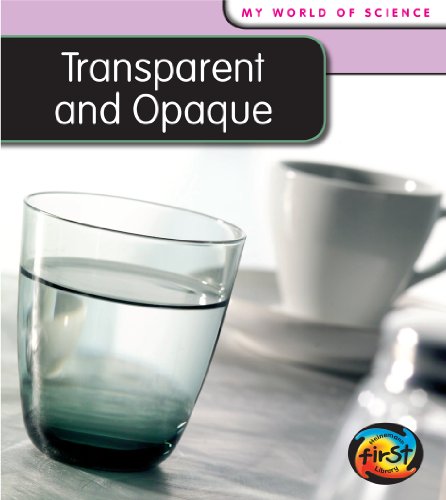-
Force: The Power Behind Movement
Eric Laithwaite
Library Binding (Franklin Watts, Oct. 1, 1986)Examines the various kinds of forces that make movement possible and discusses their application to everyday life. Includes gravity, friction, inertia, expansion, and others. W
W
-
States of Matter
Samantha Bell, Jeff Bane
Paperback (Cherry Lake Pub, Jan. 1, 2018)Using the new Next Generation Science Standards (NGSS), the My World of Science series provides the earliest readers with background on key STEM concepts. States of Matter explores basic chemistry and the states of solid, liquid, and gas in a simple, engaging way that will help readers develop word recognition and reading skills. Includes a glossary and index. WB
WB
-
Transparent and Opaque
Angela Royston
Library Binding (Heinemann, July 26, 2008)Readers will learn the difference between transparent, translucent, and opaque materials and see how each is used in everyday life. Each book in the ‘My World of Science’ series explains science that you see in the world around you and use every day. O
O
-
Color and Wavelengths
Samantha Bell, Jeff Bane
Paperback (Cherry Lake Pub, Jan. 1, 2018)Using the new Next Generation Science Standards (NGSS), the My World of Science series provides the earliest readers with background on key STEM concepts. Color and Wavelengths explores the different frequencies in light wavelengths in a simple, engaging way that will help readers develop word recognition and reading skills. Includes a glossary and index. I
I
-
Solar System
Samantha Bell, Jeff Bane
Paperback (Cherry Lake Pub, Jan. 1, 2018)Using the new Next Generation Science Standards (NGSS), the My World of Science series provides the earliest readers with background on key STEM concepts. Solar System explores basic planetary astronomy in a simple, engaging way that will help readers develop word recognition and reading skills. Includes a glossary and index. J
J
-
Solids, Liquids and Gases
Angela Royston
Paperback (Heinemann/Raintree, Jan. 1, 2002)Royston, Angela M
M
-
Magnetic and Nonmagnetic
Angela Royston
Library Binding (Heinemann, July 26, 2008)Are all metals magnetic? Can magnetism pass through other materials? What do compasses do? Read ‘Magnetic and Nonmagnetic’ to find out! Learn how people use magnets every day, and how magnets can even work in water. Each book in the ‘My World of Science’ series explains science that you see in the world around you and use every day. O
O
-
My World of Science: Living and Non Living
Angela Royston
Hardcover (Heinemann Educational Books - Library Division, Jan. 24, 2003)None
-
Science: Reproducible Grade 2
STECK-VAUGHN
Paperback (STECK-VAUGHN, Sept. 1, 2003)Support and extend your science curriculum with this activity-rich program! Meeting NSTA standards in Life, Physical, and Earth & Space Science, this extensive resource provides a wonderful blend of background information for the teacher, cross-curricular activities, projects and experiments, and assessments that enrich and extend science period. All-inclusive presentation of life, physical, and earth & space sciences. Useful background information ideal resource for teachers with limited science exposure as well as the veteran science educator. Projects and experiments that will intrigue students and that use easy-to-find materials. Plenty of graphic organizers, including charts, tables, maps & graphs. Assessments that are ideal as pretests, posttests; perfect for portfolios. Lists of books for further reading allowing students to pursue individual interests and expand into other curriculum areas. Correlation to FOSS standards. M
M
-
Earth Science in Your Everyday Life
Gina Hagler
Paperback (Enslow Publishing, July 15, 2019)How does the temperature of ocean water make a difference in the strength of tropical storms? This question and many others can be answered with the principles of earth science. Supporting the Next Generation Science Standards, this book discusses everyday events to describe earth science principles in action. Each chapter contains a sidebar with information on places such as the Ring of Fire and the role Cepheid variable stars play in calculating the distance of objects in space. Simple experiments provide students an opportunity to see the science firsthand. Z
Z
-
Chemistry in Your Everyday Life
Thomas R. Rybolt
Library Binding (Enslow Publishing, July 15, 2019)How do soaps and detergents clean? Why do metals conduct electricity? How does burning fossil fuel contribute to global warming? The answers to these questions are found by examining the properties and behaviors of atoms and molecules. Insightful explanations and hands-on science activities simplify complicated chemistry principles into pieces of information that are more easily grasped. Sidebars include discussions on animals that can live thirty years without water, the Maillard reaction responsible for the taste and texture of french fries, the increase of carbon dioxide in the atmosphere, and how tires provide a cushion of air to smooth our rides. This book allows students to appreciate that when it comes to understanding the world around us, tiny molecules can provide big explanations. Z
Z
-
Biology Dynamic Processes
Seymour Rosen
Paperback (Globe Fearon Co, Jan. 1, 1992)Workbook exercises and experiments guide the user to understand and explore the basic biological concepts in cells, how genes influence offspring, and the functions of the human body. P
P